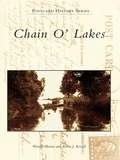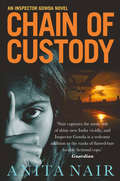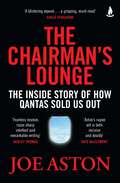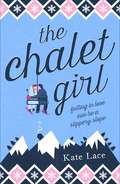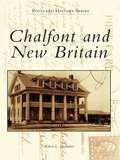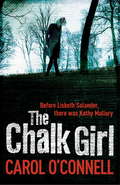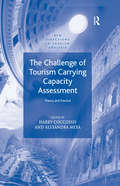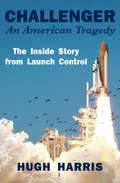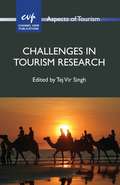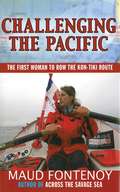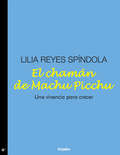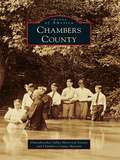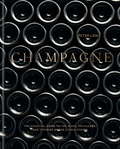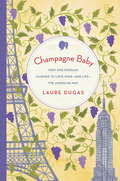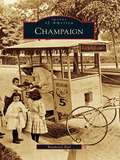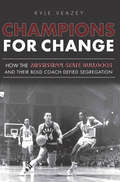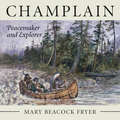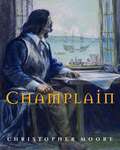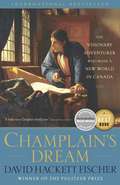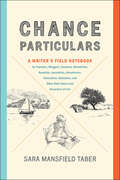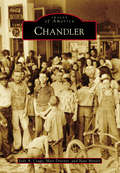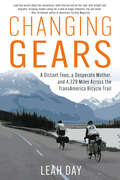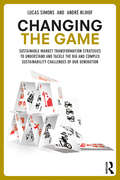- Table View
- List View
Chain O' Lakes (Postcard History)
by Wendy Maston Robin J. KessellThe Chain O' Lakes region has been one of Chicago's premier vacation spots since the 1880s. The nine major lake basins--Catherine, Channel, Grass, Bluff, Marie, Fox, Nippersink, Petite, and Pistakee--are all connected by the Fox River waterway and have for over 100 years been northern Illinois's leading destination for inland boaters, fishermen, picnickers, or those just hoping to relax and play at the beach. Luxurious mansions and swank resorts once dotted the more than 6,000 acres of shoreline. Many are gone today; some remain but have been vastly changed, but none are forgotten. Captured here in over 200 vintage postcards are scenes from the chain's heyday, scenes that will seem at once faraway and familiar to the water-skiers, windsurfers, and other outdoor recreationists who populate the Chain O' Lakes today.
Chain of Custody
by Anita NairWhat does thirteen-year-old Nandita's disappearance have to do with the murder of a prominent lawyer in a gated community? As Gowda investigates, he is suddenly embroiled in Bangalore's child-trafficking racket. Negotiating insensitive laws, indifferent officials, and uncooperative witnesses, he is in a race against time to rescue Nandita from one of the most depraved criminal rings he has ever encountered.
The Chairman's Lounge: The inside story of how Qantas sold us out
by Joe AstonFrom the must-read journalist on how power, money and influence work in this country, the full story of how one of the nation's favorite brands brought itself to ground.Before Covid, both Qantas and its CEO Alan Joyce were flying high, the darlings of customers, staff and investors. After Covid hit, only money mattered – in particular, the company's share price and extraordinary executive bonuses. Illegally redundant workers, unethical flight credits, abysmal customer service, antique aircraft: these became Qantas' new brand. How did things go so badly wrong? Why were customers at the end of the queue? And how did an increasingly autocratic Joyce constantly get his own way, with the Qantas board and with both Liberal and Labor governments, which handed out over billions in subsidies and protected lucrative flight routes from foreign competition? For the first time, The Chairman's Lounge tells the full story of how one company banked the nation's loyalty and then cashed in on it. In his celebrated Rear Window column for the Australian Financial Review , Joe Aston's reporting of the ethical failings of Qantas spurred the early retirement of its CEO and the resignation of its chairman. With fresh interviews and revelations, written in Aston's trademark swashbuckling style , The Chairman's Lounge is the definitive account of how Qantas was brought to the ground and who did it. It is a parable of our times. 'A masterclass in investigative journalism... A scathing, unflinching takedown of greed, delusion and a shameless abuse of power, both jaw-dropping and brilliantly incisive' Adele Ferguson
The Chalet Girl: The winter romance you don't want to miss this year!
by Kate LaceSnowy pistes and sexy ski instructors...Chalet girl Millie Braythorpe should be in heaven! But after four months of endless bed-making and cooking for guests, her 'glamorous' ski season feels more like hell. The only thing she looks forward to these days is her nightly gig, singing in a little French bar.But when handsome troublemaker Luke comes to stay at her chalet, Millie falls head over skis in love...But is Luke to be trusted, or is her Alpine romance destined to end in disaster?
Chalfont and New Britain
by Robert L. ShowalterNew Britain Township, founded in 1723, was a rural farming community originally settled by Welsh Baptists and German Mennonites. This changed dramatically in 1856 when the North Pennsylvania Railroad was built. Two train stations were built in the township and were named Chalfont and New Britain. The villages next to these stations attracted numerous new residents and businesses. The local picnic grove was even converted into an amusement park, which became known as Forest Park. The villages surrounding these railroad stations grew until residents decided to create their own separate boroughs, establishing Chalfont Borough in 1901 and New Britain Borough in 1928. The postcards and pictures in Chalfont and New Britain include images of the villages of Chalfont, New Britain, Line Lexington, and New Galena, as well as scenes of historic homes, hotels, stores, churches, schools, and the businesses and people who lived and worked in the community.
The Chalk Girl
by Carol O'ConnellThe little girl appeared in Central Park: red-haired, blue-eyed, smiling, perfect - except for the blood on her shoulder. It fell from the sky, she said, while she was looking for her uncle, who turned into a tree. Poor child, people thought. And then they found the body in the tree.For NYPD detective, Kathy Mallory, there is something about the girl that she understands. Mallory is damaged, they say, but she can tell a kindred spirit. And this one will lead her to a story of extraordinary crimes; murders stretching back fifteen years, blackmail and complicity and a particular cruelty that only someone with Mallory's history could fully recognise. In the next few weeks, Kathy Mallory will deal with them all ... in her own way.
The Chalk Girl: Kathy Mallory: Book Ten (Kathy Mallory #10)
by Carol O'ConnellThe little girl appeared in Central Park: red-haired, blue-eyed, smiling, perfect - except for the blood on her shoulder. It fell from the sky, she said, while she was looking for her uncle, who turned into a tree. Poor child, people thought. And then they found the body in the tree.For NYPD detective, Kathy Mallory, there is something about the girl that she understands. Mallory is damaged, they say, but she can tell a kindred spirit. And this one will lead her to a story of extraordinary crimes; murders stretching back fifteen years, blackmail and complicity and a particular cruelty that only someone with Mallory's history could fully recognise. In the next few weeks, Kathy Mallory will deal with them all ... in her own way.(P)2012 Headline Digital
The Challenge of Tourism Carrying Capacity Assessment: Theory and Practice (New Directions in Tourism Analysis)
by Harry Coccossis Alexandra MexaPlanning and management for tourism growth is becoming essential in the context of sustainable development. Particularly so since many tourist destinations are facing severe pressures from tourist flows and activities. Such pressures are evidenced in terms of dysfunctions (congestion, environmental degradation, etc) which ultimately affect the attraction and competitiveness of tourism destinations. The development of tourism should be considered in accordance with sustainability principles. In this context respecting the capacity of the local system to sustain growth becomes a key challenge. This book examines the use of various tools to define, measure and evaluate tourism carrying capacity (TCC) - a tool aiming to impose limits for entering certain tourist destinations or using certain activities. Drawing on case studies from France, Spain, Italy, Greece, the UK, the Netherlands, Ireland, Belgium, Austria, Germany and Finland, it presents practical experiences of implementing TCC in various tourist destinations (i.e. historic towns, coastal zones, islands, etc). It draws conclusions regarding the measurement and implementation of TCC assessment and provides further guidelines towards a comprehensive methodological framework for assessing tourism sustainability in the future.
Challenger: The Inside Story from Launch Control
by Hugh HarrisThe former launch commentator &“offers a personal—and sometimes painful—look back at one of the darkest chapters in US human spaceflight&” (Space.com). On January 28, 1986, the space shuttle Challenger launched from the Kennedy Space Center in Florida. Seventy-three seconds after launch, the fiery breach of a solid motor joint caused a rupture of the propellant tanks, and a stunned nation watched as flames engulfed the craft, killing all seven crew members on board. It was Hugh Harris, &“the voice of launch control,&” whom audiences across the country heard counting down to lift-off on that fateful day. With over fifty years of experience with NASA&’s missions, Harris presents the story of the Challenger tragedy as only an insider can. With by-the-second accounts of the spacecraft&’s launch and a comprehensive overview of the ensuing investigation, Harris gives readers a behind-the-scenes look at the devastating accident that grounded the shuttle fleet for over two years. This book tells the whole story of the Challenger&’s tragic legacy.
Challenges in Tourism Research
by Tej Vir SinghIn this volume leading experts from different disciplines and diverse geographic regions discuss fundamental, often controversial topics in the field of tourism studies. The book attempts to understand, identify and analyse some of the perennial problems and challenges encountered by tourism researchers. The debates include topics such as the concept of the 'tourist', the long-term sustainability of tourism development, the growth of volunteer tourism and the vulnerability of tourism. Bringing together the collective wisdom of 37 renowned tourism scholars in a unique format, this is an important text for undergraduate and postgraduate students, tourism researchers and industry professionals.
Challenging the Pacific: The First Woman to Row the Kon-Tiki Route
by Maud FontenoyJust two years after rowing solo across the North Atlantic at the age of twenty-five, Maud Fontenoy was ready for a new challenge-crossing the Pacific Ocean. Leaving from Lima, Peru, and traveling 4,400 miles in seventy-three days, Fontenoy landed in Hiva Oa in French Polynesia, becoming the first woman to complete what is known as the "Kon-Tiki" route. Alone at sea for days and nights on end, Fontenoy's story relates the ups and downs of her time at sea, from circling sharks to the celebrity welcome upon her journey's end. Named one of Time Magazine International's thirty most important people of 2005, Fontenoy presents the reader with a terrific, entertaining adventure story on the high seas as she faces the Pacific Ocean. Fontenoy overcame the odds as well as her personal doubts and fears, demonstrating not only her indomitable courage and strength, but proving once again that women can conquer the most difficult and treacherous obstacles.
El chamán de Machu Picchu
by Reyes Lilia Spíndola"Este libro es un testimonio real que te comparto para que viajes conmigo. Acompáñame, caminemos juntos en este recorrido mágico hacia una iniciación chamánica en Machu Picchu, recinto lleno de tradición y de magia. Nos guía un maestro conocedor de los secretos de la antigua civilización inca. Ven, entremos al impresionante centro de energía cósmica que se halla entre los picos de la Cordillera de los Andes,entre las ruinas majestuosas que nos contarán su historia. Lejos de la prisa y del ruido, la Madre Tierra, tu anfitriona, la Pachamama, te mostrará el camino del Inca y te llevará al encuentro de tu luz interior: tu propia conciencia. Vivirás esta iniciación chamánica con todos sus rituales aquí descritos,a la vez que te guío en meditaciones que te transportarán suavemente aun espacio de tiempo sagrado. Todo está en este libro que escribí con el único fin de que tú y yo vayamos juntos en este camino. Déjate encantar con los mitos y la esencia de Perú en este viaje quenunca olvidarás." Lilia Reyes Spíndola
Chambers County
by Chambers County Museum Chattahoochee Valley Historical SocietyChambers County, created in 1832, embraces the southernmost hills and streams of the Piedmont Plateau and sections of the Chattahoochee River to the east and the Tallapoosa River to the west. Cotton cultivation and textile manufacturing propelled the trajectory of the first 150 years in the county. Images of America: Chambers County presents an array of images of places and people who began life on the frontier, created local government, experienced Native American uprising, served in the Civil War and two world wars, cultivated thousands of productive acres with ox and mule, organized towns, constructed railroads, and built one of the nation's largest textile operations. This bounty of photographs, most of which was provided from family collections, furthers an understanding of the unique story of Chambers County in the ongoing development of the American experience.
Champagne: The essential guide to the wines, producers, and terroirs of the iconic region
by Peter LiemWinner of the André Simon Drinks Book of the Year Award.Winner of the IACP award in Wine, Beer & SpiritsA stunning box set, complete with seven vintage maps in a pull-out drawer.Based on six years of on-the-ground research and unprecedented access to actual Champagne growers, Champagne is the first book to actually describe producers and wines based on their terroir - enlightening readers by showing them exactly where, how, and by whom these great wines are made. Champagne is one of the most iconic, sought-after wines in the world, beloved by serious wine collectors as well as everyday wine drinkers. However, it is also one of the most misunderstood wines out there - obscured by a multimillion-pound marketing industry that makes it difficult for consumers to honestly judge value and understand what they're drinking.Included in the stunning box set are the Louis Larmat vinicultural maps - the only detailed wine maps of the region, which were commissioned by the French government in the mid-1940s and have never appeared in print in English.
Champagne Baby: How One Parisian Learned to Love Wine-and Life-the American Way
by Laure DugasFresh, charming, and wholly irresistible, Champagne Baby turns a familiar tale on its head: Instead of yet another American seeking the French secret to good living, a Frenchwoman finds her purpose--much to her surprise--in America. Laure Dugas is a champagne baby, born into a family of winemakers from two storied regions of France: Champagne and the Rhône Valley. When Laure was an infant, her mother would dip a finger in wine and dab it on Laure's lips to acclimate her to the taste and aroma. But Laure wants little to do with the family business. It is only at age twenty-three, when her uncle offers to send her to New York City to learn English and represent his wines to the American market, that Laure bids adieu to her boyfriend and begins her journey of discovery. The job, it turns out, is both harder and easier than expected. Laure must speak in a new language about a subject in which she has no expertise. But an experienced wine saleswoman shares the secret for faking it: "Always. Be. French." After all, who could claim to know more about wine than a Frenchwoman? With the pedigree of an expert, even as she feels like a fraud, Laure dives into an industry still dominated by men, winning over restaurateurs and sommeliers, diligently developing her palate, and traveling across the vast country that is her new home. For the first time, Laure is able to distinguish among the famous wines of her native land. She learns to greet a wine by the nose and judge a bottle not by its industry rating but by the balance of its flavors. Overcoming homesickness, culture shock, and the trials of a long-distance relationship, Laure manages to settle into her new milieu, her wine-glass-half-full attitude turning an eight-month stint into a three-year adventure. Part coming-of-age memoir, part travelogue, sprinkled throughout with regional maps and wine recommendations, Champagne Baby imparts the critical lessons that pair with both wine and life: You're Better Than the Cheapest Bottle, There's Always Occasion for Champagne, and Trust Your Palate. It encourages readers to view themselves and their surroundings with newfound appreciation, and to raise their glasses with open-mindedness and joy.Advance praise for Champagne Baby "A coming-of-age story of a French girl in love with America, Champagne Baby is a compulsive read filled with keen observations and sharp descriptions of place and culture--a modern, exuberant tale of two cities and discovery."--Mireille Guiliano, author of French Women Don't Get Fat "It is nearly impossible to read Dugas's charming, heartfelt memoir and not feel a little effervescent. Champagne Baby is a tender coming-of-age story set in an oenophile's playground. Her Franco-American spirit--marked with new traditions like champagne on Thanksgiving--combines the best of the Old and New worlds. Champagne Baby is, like the best bottle of wine, fun and complex, sensual and smart, and totally satisfying."--Hannah Howard, columnist, "Scoop du Jour" "An enticing story that evolves and ventures into unexpected directions and nourishes a result that Dugas had never imagined."--Richard Vine, PhD, author of The Curious World of Wine "[A] delightful memoir . . . [Dugas] entertainingly reflects on what she learned about herself, her family's wine business, and wines in general while living in the U.S."--Kirkus ReviewsFrom the Hardcover edition.
Champaign
by Raymond BialThe low-lying prairie on which Champaign came to be established was once described as "one vast pond where the mud turtle and water moccasin luxuriated, the mosquito wound his bugle, and the frogs gave a rival symphony." From humble origins as a stop on the Illinois Central Railroad called West Urbana, the cluster of buildings quickly became a bustling town of square storefronts, with horses and wagons hitched along wood-plank sidewalks. Gradually rising above muddy thoroughfares, Champaign grew into a charming city in which trolleys rumbled along brick streets. Elegant homes were built and churches established, along with shops and stores, and municipal services and utilities, not to mention parks, opera houses, and confectioneries.
Champions For Change: How the Mississippi State Bulldogs and Their Bold Coach Defied Segregation (Sports)
by Kyle VeazeyMississippi State dominated Southeastern Conference basketball in the late 1950s and early 1960s. Starting in 1959, the team won four conference titles over five seasons. Yet despite earning their way, the Bulldogs remained routinely absent from NCAA tournaments. Amid a climate of fierce segregation, Mississippi refused to allow its collegiate teams to compete with integrated programs. In 1963, one team determined to compete on the national stage made state history. Led by beloved coach Babe McCarthy and supported by university students and administration, the Bulldogs made a daring and furtive trip to play Loyola's integrated team in the national tournament. Now, sports journalist Kyle Veazey vividly recounts the amazing journey of a team that refused to be hindered by the status quo.
Champlain: Peacemaker and Explorer
by Mary Beacock FryerSamuel de Champlain has long been known as the founder of Quebec and as a tireless explorer. No one knows for sure where he was born or who he really was. Still, his career was packed with interesting details and his early life prepared him for greatness.Without Champlains own detailed records, the years 1600 to 1640 in Canada would be almost a mystery. Possibly Canadas first multicultural advocate, he dreamed of creating a new people from French and Aboriginal roots. However, his efforts to establish a colony encountered setbacks in France. Among his detractors was the powerful Cardinal Richelieu. Champlain was not of the nobility and thus was considered unfit for patronage.The explorers story is an exciting one, as he explored new territory, established alliances and understandings with Natives, waged war when necessary, and left behind a legend in the New World that lasts to this day.
Champlain
by Christopher Moore Francis Back"One July day four hundred years ago, Samuel de Champlain stepped out of a small boat at Quebec and began a great adventure." So begins Christopher Moore's riveting account of the life of the extraordinary, daring "father of New France." Samuel de Champlain helped found the first permanent French settlement in the New World; he established the village that eventually became the great city of Quebec; he was a skilled cartographer who gave us many of our first accurate maps of North America; he forged alliances with Native nations that laid the foundations for vast trading networks; and as governor, he set New France on the road to becoming a productive, self-sufficient, thriving colony. But Champlain was also a man who suffered his share of defeats and disappointments. That first permanent settlement was abandoned after a disastrous winter claimed the lives of half the colonists. His marriage to a child bride was unhappy and marked by long separations. Eventually Quebec had to be surrendered temporarily to the English in 1629. In this remarkable book, illustrated entirely with paintings, archival maps, and original artifacts, Christopher Moore brings to life this complex man and, through him, creates a portrait of Canada in its earliest days. Champlain is illustrated with archival maps and paintings. Additional artwork has been provided by Francis Back.From the Hardcover edition.
Champlain's Dream: The Visionary Adventurer Who Made A New World In Canada
by David Hackett FischerIn this sweeping, enthralling biography, acclaimed Pulitzer Prize–winner David Hackett Fischer magnificently brings to life the visionary adventurer who has straddled our history for 400 years. Champlain’s Dream reveals, with rare immediacy and drama, the story of a remarkable man: a leader who dreamed of humanity and peace in a world riven by violence; a man of his own time who nevertheless strove to build a settlement in Canada that would be founded on harmony and respect. With consummate narrative skill and comprehensive scholarship, Fischer unfolds a life shrouded in mystery, a complex, elusive man among many colorful characters. Born on France’s Atlantic coast, Samuel de Champlain grew up in a country bitterly divided by religious wars. But, like Henry IV, one of France’s greatest kings whose illegitimate son he may have been and who supported his travels from the Spanish Empire in Mexico to the St. Lawrence and the unknown territories, Champlain was religiously tolerant in an age of murderous sectarianism. Soldier, spy, master mariner, explorer, cartographer, and artist, he maneuvered his way through court intrigues in Paris, supported by Henri IV and, later, Louis XIII, though bitterly opposed by the Queen Regent Marie de Medici and the wily Cardinal Richelieu. But his astonishing dedication and stamina triumphed…. Champlain was an excellent navigator. He went to sea as a boy, acquiring the skills that allowed him to make 27 Atlantic crossings between France and Canada, enduring raging storms without losing a ship, and finally bringing with him into the wilderness his young wife, whom he had married in middle age. In the place he called Quebec, on the beautiful north shore of the St. Lawrence, he founded the first European settlement in Canada, where he dreamed that Europeans and First Nations would cooperate for mutual benefit. There he played a role in starting the growth of three populations — Québécois, Acadian, and Métis — from which millions descend. Through three decades, on foot and by ship and canoe, Champlain traveled through what are now six Canadian provinces and five American states, negotiating with more than a dozen Indian nations, encouraging intermarriage among the French colonists and the natives, and insisting, as a Catholic, on tolerance for Protestants. A brilliant politician as well as a soldier, he tried constantly to maintain a balance of power among the Indian nations and his Indian allies, but, when he had to, he took up arms with them and against them, proving himself a formidable strategist and warrior in ferocious wars.Drawing on Champlain’s own diaries and accounts, as well as his exquisite drawings and maps, Fischer shows him to have been a keen observer of a vanished world: an artist and cartographer who drew and wrote vividly, publishing four invaluable books on the life he saw around him. This superb biography (the first full-scale biography in decades) by a great historian is as dramatic and richly exciting as the life it portrays. Deeply researched, it is illustrated throughout with 110 contemporary images and 37 maps, including several drawn by Champlain himself.
Chance Particulars: A Writer's Field Notebook for Travelers, Bloggers, Essayists, Memoirists, Novelists, Journalists, Adventurers, Naturalists, Sketchers, and Other Note-Takers and Recorders of Life
by Sara Mansfield TaberAn essential guide for writers on how to record and use rich detail to enliven their work.The goal of the writer is to live with the keenness of the foreigner. To experience, wide-eyed, the sensations aroused and the events offered up by peculiar surrounds and then to evoke them so brightly on the page that the reader, too, experiences the foreigner’s frisson. A time-honored way this is accomplished is through the keeping of a field notebook—through the faithful recording of the this-and-that of life; the atmospheres and incidents; the bells, the beer, the bread.Based on what accomplished nonfiction writer Sara Mansfield Taber learned in her many years of field notebook keeping, Chance Particulars is a unique and handy primer for writers who want to use their experiences to tell a lively, satisfying story. Often, writers try to turn their notes into a memoir, essay, travel piece, or story, only to find that they haven’t recorded enough of the concrete, sensory details necessary to create evocative description. To help writers overcome this problem, Taber has composed a true "field notebook for field notebook keepers." Enhanced by beautiful illustrations, this charming and comprehensive guide is a practical manual for anyone who wishes to learn or hone the crafts of writing, ethnography, or journalism.Writers of all levels, genres, and ages, as well as teachers of writing, will appreciate this useful tool for learning how to record the details that build vibrant prose. With this book in hand, you will be able to recreate times and places, conjure up intricate character portraits, and paint pictures of particular landscapes, cultures, and locales.
Chance Particulars: A Writer's Field Notebook for Travelers, Bloggers, Essayists, Memoirists, Novelists, Journalists, Adventurers, Naturalists, Sketchers, and Other Note-Takers and Recorders of Life
by Sara Mansfield Taber“A guide to paying attention to the concrete, sensory details of experience and the process of getting them down on the page.” —James Barilla, author of My Backyard JungleBased on what accomplished nonfiction writer Sara Mansfield Taber learned in her many years of field notebook keeping, Chance Particulars is a unique and handy primer for writers who want to use their experiences to tell a lively, satisfying story. Often, writers try to turn their notes into a memoir, essay, travel piece, or story, only to find that they haven’t recorded enough of details necessary to create evocative description. To help writers overcome this problem, Taber has composed a true “field notebook for field notebook keepers.” Enhanced by beautiful illustrations, this charming and comprehensive guide is a practical manual for anyone who wishes to learn or hone the crafts of writing, ethnography, or journalism.Writers of all levels, genres, and ages, as well as teachers of writing, will appreciate this useful tool for learning how to record the details that build vibrant prose. With this book in hand, you will be able to recreate times and places, conjure up intricate character portraits, and paint pictures of particular landscapes, cultures, and locales.“At once a delicious read and the distilled wisdom of a long-time teacher and virtuoso of the literary memoir. Her powerful lessons will give you rare and vital skills: to be able to read the world around you, and to read other writers, as a writer, that is, with your beadiest conjurer’s eye and mammoth heart. This is a book to savor, to engage with, and to reread, again and again.” —C. M. Mayo, author of Miraculous Air
Chandler
by Jody A. Crago Mari Dresner Nate MeyersChandler is located 20 miles southeast of Phoenix and has been the home of innovative, forward-thinking people for many decades. As Phoenix began to grow in the late 19th century, a young veterinarian decided to aquire several acres of the surrounding land. Dr. Alexander J. Chandler took a few business gambles with his new acquisition, and the 18,000 acres known then as Chandler Ranch were soon split into lots and sold as the new town of Chandler. Once the town was established in 1912, Dr. Chandler relied on industrial agriculture and the new, lavish San Marcos Hotel to attract new residents. Later, Dr. Chandler brought Frank Lloyd Wright to redesign downtown and build a new hotel. During World War II, several families and businesses came to the area because of the new Williams Air Force Base. Following the war, high-tech businesses and bioscience firms created a new economy in Chandler, which led to a modern patchwork of people who represent Chandler today.
Changing Gears: A Distant Teen, a Desperate Mother, and 4,329 Miles Across the Transamerica Bicycle Trail
by Leah DayWhat happens when a mother and her 16-year-old son drop everything to bike across the country? On the TransAmerica Bicycle Trail, they struggle up hills in the pouring rain, they feel soreness in muscles they didn&’t know they had, and they learn more about each other than they ever knew before. When licensed clinical therapist and self-proclaimed &“reluctant adventurer&” Leah Day felt herself drifting from her son, Oakley, she decided to make a drastic play to reconnect. In this memoir chronicling the journey of a lifetime, Leah and Oakley find that if they can push themselves to accomplish physically exhausting and emotionally taxing milestones on a bike, they are capable of anything!
Changing the Game: Sustainable Market Transformation Strategies to Understand and Tackle the Big and Complex Sustainability Challenges of Our Generation
by Lucas Simons Andre NijhofWe are at the beginning of the sustainability era. The biggest challenge of our generation is to reach the Sustainable Development Goals. For this we must be willing to understand and change the root causes that create these challenges in the first place. The system itself needs to change. But how to do that? This ground-breaking book Changing the Game reveals the missing insights and strategies to actually achieve system change. The authors Lucas Simons and André Nijhof bring decades of real life and academic experience, and state that most of the sustainability challenges are actually caused by the same system failures, every time. Therefore, the way to accelerate and manage system change is also similar every time – if you know where to look and how to act. The theory of sustainable market transformation and system change is described in a compelling and easy to understand eight-step approach applied to eight different sectors. The authors, together with respected sector experts, describe the drivers, triggers and dominant thinking in each of these sectors as well as the strategies needed to move towards higher levels of sustainability. This book is highly accessible and engaging, and is perfect for use by professionals, leaders and students for understanding how to move markets to a more sustainable future.
